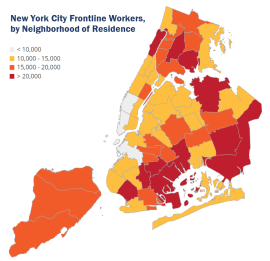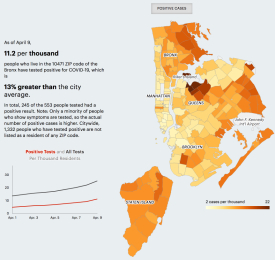From David Ruccio sources [frontline workers, coronavirus cases] As the Guardian explained earlier today, the coronavirus has discriminated in inflicting its terrible toll on the two very different cities that make up New York City. Different boroughs, even different neighborhoods within each borough, are experiencing coronavirus almost as though it were two different contagions. In wealthier white areas the residential streets are empty; parking spots that are fought over in normal times now stand vacant following an exodus to out-of-town weekend homes or Airbnbs. In places like the Bronx – which is 84% black, Latino or mixed race – the sidewalks are still bustling with people making their way into work. There is still a rush hour. “We used to call them ‘service workers’,”
Topics:
David F. Ruccio considers the following as important: Uncategorized
This could be interesting, too:
tom writes The Ukraine war and Europe’s deepening march of folly
Stavros Mavroudeas writes CfP of Marxist Macroeconomic Modelling workgroup – 18th WAPE Forum, Istanbul August 6-8, 2025
Lars Pålsson Syll writes The pretence-of-knowledge syndrome
Dean Baker writes Crypto and Donald Trump’s strategic baseball card reserve
from David Ruccio
sources [frontline workers, coronavirus cases]
As the Guardian explained earlier today, the coronavirus has discriminated in inflicting its terrible toll on the two very different cities that make up New York City.
Different boroughs, even different neighborhoods within each borough, are experiencing coronavirus almost as though it were two different contagions. In wealthier white areas the residential streets are empty; parking spots that are fought over in normal times now stand vacant following an exodus to out-of-town weekend homes or Airbnbs.
In places like the Bronx – which is 84% black, Latino or mixed race – the sidewalks are still bustling with people making their way into work. There is still a rush hour. “We used to call them ‘service workers’,” Williams said. “Now they are ‘essential workers’ and we have left them to fend for themselves.”
If you compare the map of where frontline workers live within New York (on the left above) with the map of the 76,876 confirmed cases in the city (on the right), the two are virtually identical.
“We put people out there and said you got to go to work, but we didn’t give them protective gear or additional testing to keep them safe. It was almost as though these groups were expendable to keep the city moving,” according to Jumaane Williams, the public advocate who acts as the official watchdog for New Yorkers.
So, in New York City and across the country, we’re really talking about two different outbreaks of coronavirus: one for so-called essential workers, who are forced to have the freedom to commute and work under extremely dangerous conditions, and another for everyone else, especially their employers.


